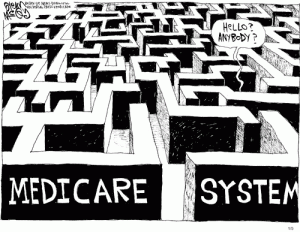Figuring out how to do great dementia care is one of the most complex, puzzling conundrums facing senior living and all of healthcare.
By Steve Moran
Figuring out how to do great dementia care is one of the most complex, puzzling conundrums facing senior living and all of healthcare. We have learned a lot. However, because we don’t really have the ability to peak under the hood as we try fresh programming and design ideas, the best we can do is infer what is working and what is not.
At Environments for Aging, Juliet Holt Klinger, Senior Director of Dementia Care, and Laura Busalacchi, Senior Director of Interior Design — both of whom are dementia experts — led a two hour deep dive into some of the most thorny and current controversies surrounding dementia design and programming. After the session I spent another hour with them doing a deeper dive.
Before I get to what they talked about, I have to make note that I love their passion for getting this dementia thing right. What I see is two people who eat sleep and drink figuring out how to serve older people with dementia with great passion and because of this passion, they are continuously exploring new and better ways and when they find those better ways, they integrate them into the Clare Bridge Memory Care Program and design.
The Big 5
Here are the big 5 areas they discussed:
-
Hidden/camouflaged exits and murals to reduce elopement risk — At first glance this seems like such a cool idea but it turns out that it is more likely to create problems and not solve them. Imagine for a minute you are have significant cognitive decline and you understand this. These camouflage devices make it even harder for you to understand what it real and what is not. You go to something that looks like a bookcase or a cabinet and try to take a book our or open the cabinet and can’t. Even without dementia it would be pretty confusing.
-
Use of fake items or motifs vs supporting meaning — Think in terms of fake sewing machines, tools, fake knives and other kitchen utilities, fake pets, fake outdoor scenes in window frames and fake skylights. In talking to Juliet and Laura the answer is IT DEPENDS. They hate most fakes but the overriding principle is: What works?
They have found robotic/animatronic cats and dolls specifically designed for use with dementia are very effective meeting resident needs. They use real things like sewing machines, typewriters, tools, and kitchen utensils and even stoves are real working appliances. They make them safe by doing things like turning off the master switch for the stoves and removing the sewing needle when the sewing machine is not being used.
With respect to things like fake landscapes if they end up deceiving the resident meaning showing summer outdoor scenes in winter or even season appropriate but not what is really outside, it contributes to the problem.
This is not to say that art cannot have those subjects or that even digital pictures of all kinds of landscapes are not okay. Think in terms of what would be okay for you or maybe your kids.
-
Hospitality aesthetic vs. functional dementia-friendly design — From their perspective and mine this is not or at least should not be an either or question. The truth is of course that we have all seen furniture and accessories that look great and are terrible for older adults. Seats that are uncomfortable or impossible to get out of; Flooring that looks great but does not have the right colors and textures; Paint colors that don’t serve residents well.
The bottom line is that first it has to work. Then it has to look good. It is possible to accomplish both, but function always has to come first.
-
Because they have dementia, we can’t use (fill in the blank). Because they have dementia, we must use (fill in the blank) — This and the next one are in some ways the most difficult. Families often choose dementia care because of safety concerns. The problem is that life at all ages has risks and those risked well managed, are critical to quality of life. This is equally true with dementia residents. This is an area that designers and owners need to think about, but a surplus of safety is terrible for quality of life.
-
Segregated vs. inclusive designs for dementia — It is clear that today most senior living communities come down on the side of a segregated and locked dementia care community or area. It reduces legal liabilities and often residents who do not have compromised cognitive abilities are not very enthusiastic about living next door to or near someone with dementia. They are even less interested in doing activities with them or dining with them. It is unclear that this is (or is not) the right thing to do.
I finished off my conversation with Juliet and Laura by asking them what they thought dementia care would be like in 5 years. Her response was that they are constantly exploring new ideas and models of dementia care and are ready to embrace the future . . . that they are already embracing the future.








